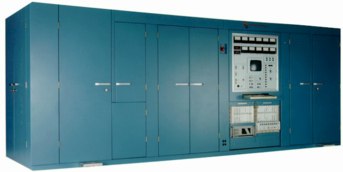| GENERAL DESCRIPTION |
 INTRODUCTION
INTRODUCTION| TECHNICAL SPECIFICATIONS | |
| RF Carrier Power (A3E) | 500 kW on all frequencies through the 3.9 to 26.1 MHz range. |
| Reduced RF Carrier Output Power (A3E) | Any power level between 50 kW and 500 kW. |
| RF Output Power (H3E & R3E) | 1000 kW PEP Two-Tone, 1500 kW PEP Program Modulation. |
| Frequency Range | 3.9 to 26.1 MHz continuous in 100 Hz increments. |
| Tuning Time | An average of 10 typical frequency changes take less than 25 seconds each. |
| Standing Wave Ratio | 2.0:1 VSWR at full power. |
| Output Impedance | 75 ohms or 50 ohms unbalanced, 300 ohms balanced. |
| Modes of Emission | AM (A3E), SSB (H3E & R3E). |
| Modulation Method | PA anode modulation using high efficiency solid state modulator. |
| Modulation Capability | 100% sinusoidal modulation at frequencies from 50 to 7,500 Hz, for ten (10) minutes per hour. Up to 70% modulation on a continuous basis. |
| Controlled Carrier Level Modulation | The Type 420 C Transmitter has the capability of operating in a controlled carrier modulation mode (CCM). This is an amplitude modulation technique that scales the amplitude of the carrier to the percentage of modulation. The carrier can be reduced as much as 6 dB below the rated value. This feature can be a major cost saving to the user. |
| Single Sideband Operation (H3E & R3E) | Single Sideband (SSB) operation is provided using a phase-amplitude method of generating the single sideband signal. |
| RF Spurious Noise | Less than 50 mW. Out of band emissions are in compliance with CCIR 328-5. |
| RF Harmonic Outputs | Less than 50 mW. |
| Audio Response (A3E) | ±1 dB from 50 Hz to 7,500 Hz at 70% modulation or any lower modulation level. |
| Audio Response | ±1 dB 100 Hz to 4,500 Hz at any level up to the average power capability. |
| Audio Harmonic Distortion (A3E) | Less than 3.5% at 90% modulation from 50 to 7,500 Hz. |
| Audio Harmonic Distortion (H3E & R3E) | Less than 3.5% at full average power capability from 100 to 4,500 Hz. |
| Intermodulation Distortion (H3E & R3E) | At least -35 dB relative to either tone of a two-tone test signal. |
| Carrier Reduction (H3E & R3E) | -6 dB to -24 dB relative to two audio tone PEP output, adjustable in 3 dB steps. |
| Audio Input Requirements | Adjustable from -8 dBm to +10 dBm for 100% modulation. |
| Audio Input Impedance | 600 ohms, or 10K ohms, balanced. |
| Carrier Level Shift (A3E) | Less than or equal to ± 3% shift at 100% ton modulation with 1,000 Hz sinewave exclusive of power line variations. |
| Carrier Noise | -56 dB unweighted referenced to 100% modulation with a 1,000 Hz tone. |
| Power Source | 4,160 Vac, or 11,000 Vac, 3 phase, three wire, 50/60 Hz. Other voltages may be accomodated on special order. Main power requirement is 1,200 kW with a 100% tone modulation condition and equal to or greater than 0.95 lagging power factor. |
| Efficiency | The overall efficiency of the Type 420 C Transmitter measured as an average of ten frequencies over the range 3.9-26.1 MHz at 500 kW carrier power level will not be less than 73% with any depth of modulation. Overall efficiency of 75% is expected during cool weather conditions and at the lower RF frequencies. |
| Ambient Temperature | +5 to +45° Centigrade, indoors -10 to +45° Centigrade, outdoors. Lower temperatures may be accommodated on special order. |
| Altitude | Up to 2,000 meters above sea level. Higher altitudes may be accommodated on special order. |
| Relative Humidity | 0 to 95%, non-condensing relative humidity. |
| Cooling | Water, water-vapor, and air cooling is employed. All necessary cooling is an integral part of the Type 420 C Transmitter. Demineralized water requirements are less than or equal to 1 gallon per day. No discrete air ducting is required. |
| Specifications may change without notice | |
| TUBE COMPLEMENT | |||
| RF stages | AF stages and modulator | ||
| Number | Type | Number | Type |
| 1 | 4CM400,000A/AG or 4CM500,000G or TH558 or TH576 or RS 2078 or BEL550,000CX |
||
| 1 | 3CW20,000A7 | ||
| THIS TYPE OF TRANSMITTER IS INSTALLED IN THE FOLLOWING COUNTRIES | |||||
| ITU | Country | ITU | Country | ||
| CHN | CHINA | QAT | QATAR | ||
| USA | USA | ||||